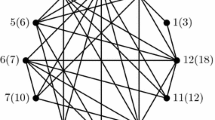Abstract
Leta 1,a 2, ...,a n be relative prime positive integers. The Frobenius problem is to determine the greatest integer not belonging to the set {Σ n j=1 a j x j :x∈Z n+ }. The Frobenius problem belongs to the combinatorial number theory, which is very rich in methods. In this paper the Frobenius problem is handled by integer programming which is a new tool in this field. Some new upper bounds and exact solutions of subproblems are provided. A lot of earlier results obtained with very different methods can be discussed in a unified way.
Similar content being viewed by others
References
[Boros 87]E. Boros, On a linear diophantine problem for geometrical type sequences,Discrete Math 66 (1987), 27–33.
[Brauer-Shockley 62]A. Brauer, J. E. Shockley, On a Problem of Frobenius,J. reine angew. Math.,211 (1962), 215–220.
[Byrnes 74]J. S. Byrnes, On a Partition Problem of Frobenius,J. Combinatorial Theory, Ser. A,17 (1974), 162–166.
[Dulmage-Mendelsohn 64]A. L. Dulmage, N. S. Mendelsohn, Gaps in the Exponent Set of Primitive Matrices,Illinois J. Math.,8 (1964), 642–656.
[Hujter 82]M. Hujter, On a Sharp Upper and a Lower Bound for the Frobenius Problem,Computer and Automation Institute of the Hungarian Academy of Sciences, Report No. MO/32.
[Johnson-Kernighan xx] S. C. Johnson andB. W. Keringhan, Making change with a minimum number of coins, manuscript, undated,Bell Laboratories, Murray Hill, New Jersey.
[Kannan 92]R. Kannan, Lattice translates of polytope and the Frobenius problem,Combinatorica 12 (1992), 161–177.
[Magazine et al. 75]M. J. Magazine, G. L. Nemhauser, L. E. Trottler, When the greedy solution solves a class of knapsack problems,Operations Research 23 (1975), 207–217.
[Roberts 56]J. B. Roberts, Note on the Linear Forms,Proc. Amer. Math. Soc.,7 (1956), 465–469.
[Selmer 77]E. Selmer, On the linear diophantine problem of Frobenius,J. reine angew. Math. 293/294 (1977), 1–17.
[Siering 74]E. Siering, Über lineare Formen und ein Problem von Frobenius,J. reine angew. Math. 271 (1974), 177–202.
[Vizvári 77]B. Vizvári, On the optimal solutions of discrete programming algorithms (in Hungarian),Alkalmazott Matemetikai Lapok,3 (1977), 139–150.
[Vizvári 84]B. Vizvári, On the connection of the Frobenius Problem and the Knapsack Problem, inColloquia Mathematica Societatis János Bolyai,37. Finite and Infinite Sets, North-Holland 1984, 799–819.
[Vizvári 87]B. Vizvári, An application of Gomory Cuts in Number Theory,Periodica Mathematica Hungarica 18 (1987), 213–228.
[Vizvári]B. Vizvári, On the Optimality of the Greedy Solutions of the General Knapsack Problem,Optimization,23 (1992), 125–138.
Author information
Authors and Affiliations
Rights and permissions
About this article
Cite this article
Vizvári, B. An application of an optimal behaviour of the greedy solution in number theory. Period Math Hung 27, 69–83 (1993). https://doi.org/10.1007/BF01876632
Received:
Issue Date:
DOI: https://doi.org/10.1007/BF01876632




